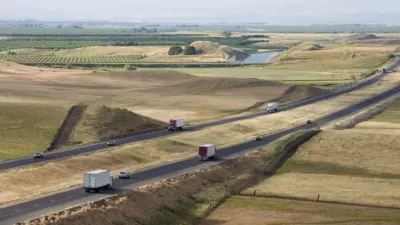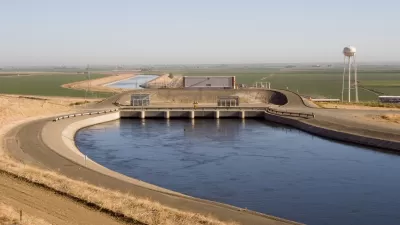This piece from Scientific American looks at the jurisdictional challenge of conserving water in the cross-state Ogallala Aquifer, one of the world's largest sources of freshwater and the backbone of the nation's farm economy.
"The Ogallala Aquifer, the vast underground reservoir that gives life to these fields, is disappearing. In some places, the groundwater is already gone. This is the breadbasket of America-the region that supplies at least one fifth of the total annual U.S. agricultural harvest. If the aquifer goes dry, more than $20 billion worth of food and fiber will vanish from the world's markets. And scientists say it will take natural processes 6,000 years to refill the reservoir.
The challenge of the Ogallala is how to manage human demands on the layer of water that sprawls underneath parts of eight states from South Dakota to Texas. As landowners strive to conserve what's left, they face a tug-of-war between economic growth and declining natural resources. What is happening here-the problems and solutions-is a bellwether for the rest of the planet."
"...By 1980 water levels had dropped by an average of nearly 10 feet throughout the region. In the central and southern parts of the High Plains some declines exceeded 100 feet. Concerned public officials turned to the U.S. Geological Survey, which has studied the aquifer since the early 1900s. With their state and local counterparts, USGS officials began monitoring more than 7,000 wells to assess the annual water-level changes.
What they found was alarming: yearly groundwater withdrawals quintupled between 1949 and 1974. In some places farmers were withdrawing four to six feet a year, while nature was putting back half an inch."
Thanks to Waterwired
FULL STORY: The Ogallala Aquifer: Saving a Vital U.S. Water Source

Study: Maui’s Plan to Convert Vacation Rentals to Long-Term Housing Could Cause Nearly $1 Billion Economic Loss
The plan would reduce visitor accommodation by 25% resulting in 1,900 jobs lost.

Alabama: Trump Terminates Settlements for Black Communities Harmed By Raw Sewage
Trump deemed the landmark civil rights agreement “illegal DEI and environmental justice policy.”

Why Should We Subsidize Public Transportation?
Many public transit agencies face financial stress due to rising costs, declining fare revenue, and declining subsidies. Transit advocates must provide a strong business case for increasing public transit funding.

Paris Bike Boom Leads to Steep Drop in Air Pollution
The French city’s air quality has improved dramatically in the past 20 years, coinciding with a growth in cycling.

Why Housing Costs More to Build in California Than in Texas
Hard costs like labor and materials combined with ‘soft’ costs such as permitting make building in the San Francisco Bay Area almost three times as costly as in Texas cities.

San Diego County Sees a Rise in Urban Coyotes
San Diego County experiences a rise in urban coyotes, as sightings become prevalent throughout its urban neighbourhoods and surrounding areas.
Urban Design for Planners 1: Software Tools
This six-course series explores essential urban design concepts using open source software and equips planners with the tools they need to participate fully in the urban design process.
Planning for Universal Design
Learn the tools for implementing Universal Design in planning regulations.
Smith Gee Studio
Alamo Area Metropolitan Planning Organization
City of Santa Clarita
Institute for Housing and Urban Development Studies (IHS)
City of Grandview
Harvard GSD Executive Education
Toledo-Lucas County Plan Commissions
Salt Lake City
NYU Wagner Graduate School of Public Service




























